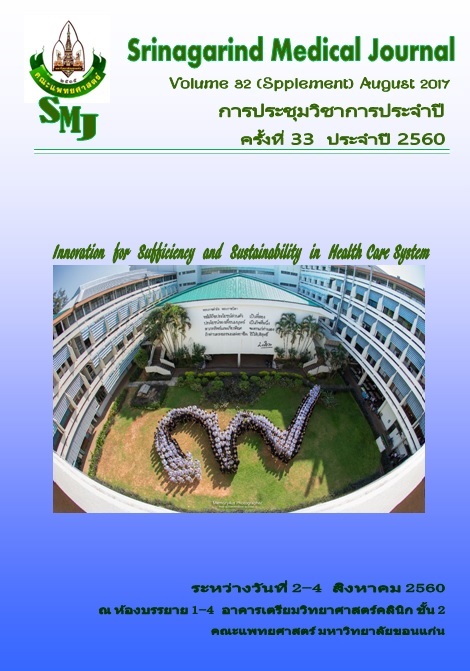Postoperative Analgesic Effect in Pediatric Lower Limb Procedure between Epidural Analgesia and Continuous Opioids Intravenous Infusion at Srinagarind Hospital 2012-2014
Keywords:
postoperative pain, pediatric lower limb procedure, epidural analgesia, continuous opioids intravenous infusionAbstract
Background and Objectives : Controlling pain after pediatric lower limb surgery has several methods such as continuous intravenous opioid infusion, local anesthesia, and epidural anesthesia. In recent years, the pediatric epidural is an accepted method of advanced analgesia in children and significantly reduce postoperative pain more than other methods. For pediatric care has difficult to assess pain scores and treatment. In this study, we compared epidural analgesia and continuous intravenous opioid infusion after general anesthesia for postoperative analgesic effect and complications in pediatric patients.
Methods : A retrospective analytical descriptive study was enrolled in 111 patients who underwent elective lower limb surgery and received different postoperative pain control between 2012-2014 (epidural group(N=33) and continuous intravenous opioid group (N=78)). The data were reviewed and recorded from postoperative pain assessment forms and anesthetic records. Pain scores were assessed from pain scores at rest and movement for postoperative analgesic effect on day 1, 2 and 3. Opioid consumption and complications such as nausea and vomiting, itching, sedation and respiratory depression were recorded.
Results : Morphine consumption after pediatric lower limb surgery in epidural analgesic patients were significantly lower compared with continuous intravenous group (median=2.2 mg and median=6.8 mg, respectively). However, the resting and movement pain scores on postoperative day 1, 2 and 3 and fentanyl consumption were not different(p>0.05). Nausea and vomiting, pruritus were adverse effect in epidural analgesic patients significantly more than intravenous group (45.5% vs 25.6%, p=0.047 and 21.2% vs 2.6%, p=0.003, respectively). Other adverse effects were not different.
Conclusion : From this study, Epidural analgesia for postoperative pain control in pediatric lower limb surgery patients was the best choice for reduction morphine consumption




